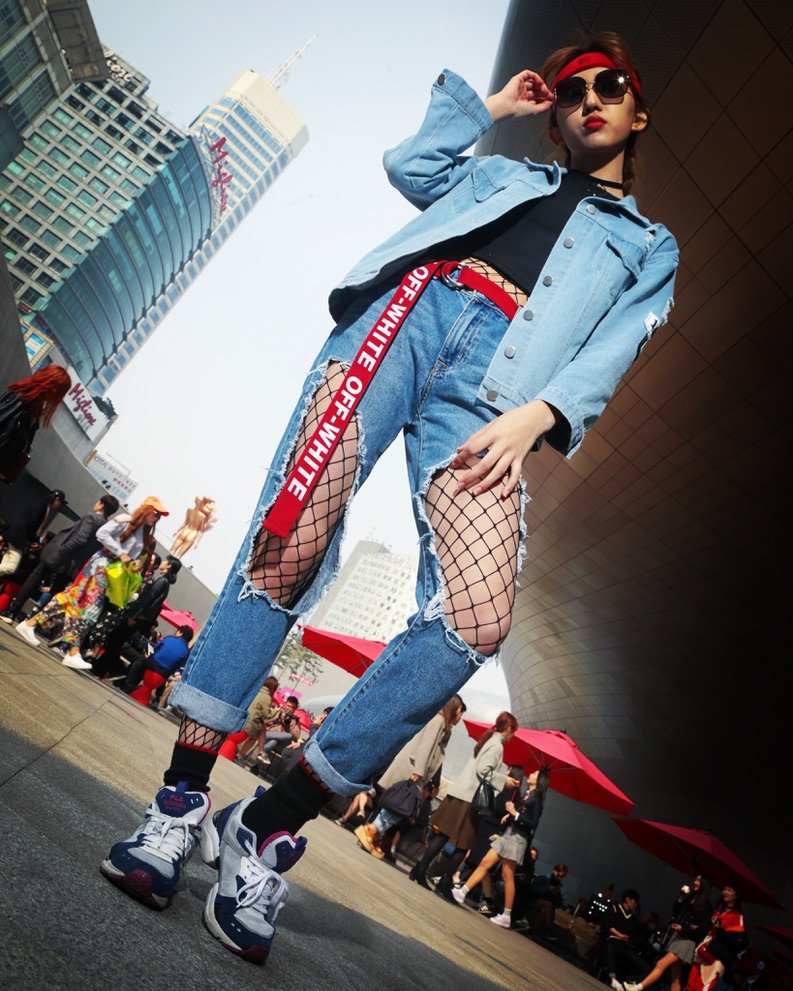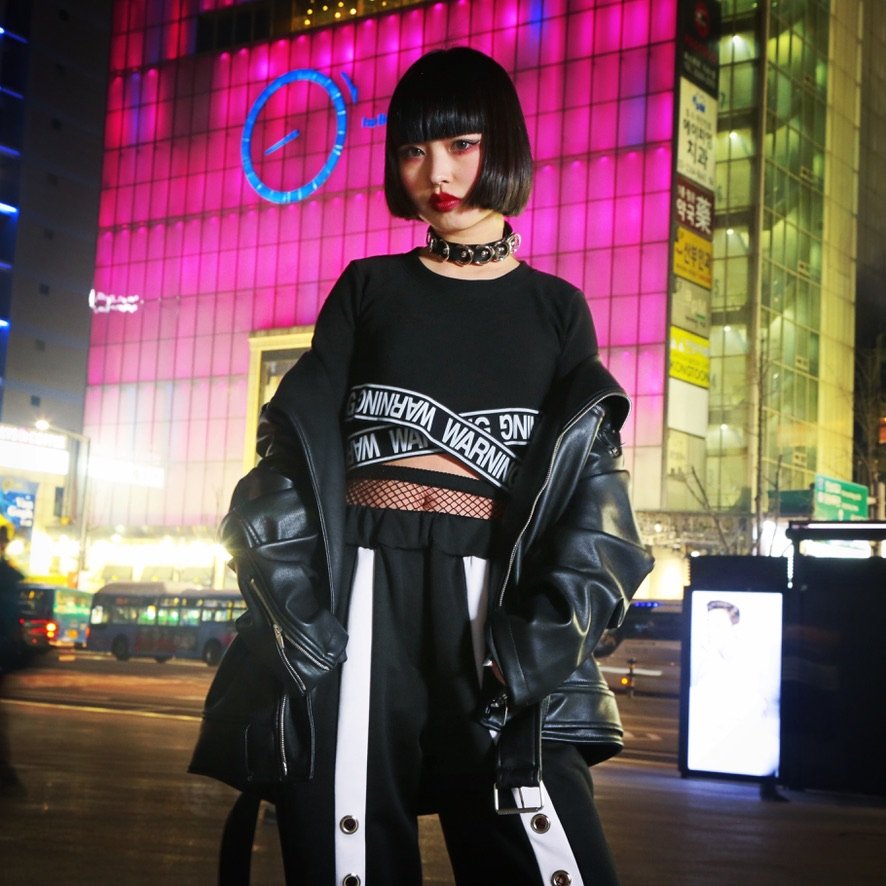Dongdaemun: Ground Zero of Korean Fashion
Vietnamese model @_almirabaoha_ towers above everything around her from deep inside the DDP building, even as her industrial gray, futurustic aesthetic effortlessly blends in with the structure.
All you never knew you didn’t know about Dongdaemun.
The Heunginjimun, 2016. Used under Wikipedia Commons terms. Copyright: Jiyounnng.
Dongdaemun, nestled in the heart of Seoul, South Korea, is a district rich in historical and cultural significance. Its origins date back to the Joseon Dynasty when Heunginjimun, commonly known as Dongdaemun (meaning "Great East Gate"), was erected in 1396 as a crucial part of the Seoul Fortress Wall. This monumental gate served both as a critical defense mechanism and a nucleus for economic activities. Officially named "Heunginjimun" during King Sejo's reign in 1453, it epitomized the strength and prosperity of the burgeoning city.
The early 20th century witnessed Dongdaemun's modernization during the Japanese occupation of Korea. The construction of the Gyeongseong Electric Company Streetcar line in 1905, which included a stop at Dongdaemun, catalyzed substantial commercial growth. In 1925, the establishment of Dongdaemun Stadium marked another transformative milestone. This stadium soon became a central venue for sports and public events, enriching the area's vibrant communal life until its demolition in the early 21st century.
A snapshot of Dongdaemun Stadium (where DDP now sits) before it was demolished in 2005.
Yun, Jieheerah. “Construction of the World Design Capital: Détournement of Spectacle in Dongdaemun Design Park & Plaza in Seoul.” Journal of Asian Architecture and Building Engineering 13, no. 1 (2014): 17–24. https://doi.org/10.3130/jaabe.13.17.
Post-Korean War, throughout the 1950s and 1960s, Dongdaemun emerged as a thriving commercial district. The market in Dongdaemun flourished remarkably, especially as a wholesale clothing market, drawing traders and consumers nationwide. This boom in trade established Dongdaemun not merely as a commercial hub but as a significant center for textile production. During this period, the Peace Market (Pyeonghwa Sijang) was established, becoming one of the key marketplaces in the area. Opened in 1960, the Peace Market quickly grew into a bustling center for the garment industry, with countless small vendors producing and selling a wide array of clothing. The Peace Market played a vital role in South Korea's economic recovery post-war, providing employment opportunities and fostering the growth of the textile industry.
Dongdaemun wasn't always the bright and shiny place it is today.
The Peace Market is also notable for its role in South Korea’s labor movement. In the 1970s, young female workers in the garment industry, faced with harsh working conditions and low wages, began to organize for better labor rights. The movement was catalyzed by the tragic story of Jeon Tae-il, a young tailor at the Peace Market, who in 1970 self-immolated in protest against the poor working conditions and labor abuses. His sacrifice galvanized public attention and became a pivotal moment in South Korea's labor history, leading to increased labor activism and improvements in working conditions.
The legendary Migliore “private-branded hive,” standing directly across from the DDP, was ground-zero for that kind of retail model, with Doota and APM and others to soon follow. This model’s street fashion was (perhaps directly and but certainly by extension) the product of Migliore, looming directly behind her.
Transitioning into the late 20th and early 21st centuries, Dongdaemun saw further transformation. In 1998, the area was declared the Dongdaemun Fashion Town Special Tourist Zone to accommodate the rising flux of domestic and international visitors, cementing its reputation as a top fashion and retail destination. A significant milestone in this transformation was the launch of Migliore in the same year. Migliore is a massive shopping complex that quickly became one of Dongdaemun's most iconic landmarks. It features over ten floors of retail space, housing hundreds of stores that offer the latest in fashion trends at competitive prices. This mega-shopping establishment operates almost around the clock, embodying the district's 24-hour shopping culture. Moreover, Migliore serves as a "private-branded hive" (PBH), where numerous small vendors create and sell their distinct, private-label products. This model has inspired other complexes in Dongdaemun, leading to the emergence of additional PBHs such as Doosan Tower (Doota) and Hello apM, which further bolstered the area's reputation as a cutting-edge fashion and retail hub.
A Japanese visitor to Seoul Fashion Week in 2017 stands in front of the DDP, across from the APM structure.
The turn of the century brought about ambitious urban renewal projects, spearheaded by the Seoul Metropolitan Government starting in 2003, to modernize infrastructure. The highlight of Dongdaemun's modern evolution is the Dongdaemun Design Plaza (DDP), constructed from 2007 and officially opened in 2014. Designed by the acclaimed architect Zaha Hadid, the DDP is celebrated for its futuristic architecture and multifunctional spaces. The design embodies Hadid's "parametricism" philosophy, an avant-garde approach characterized by fluid, interconnected, and organic forms that create a continuous, dynamic spatial experience. Parametricism is unique in its adaptability, allowing the space to respond dynamically to the needs of its users, thereby providing a versatile environment that accommodates a variety of activities and functions seamlessly. This design philosophy makes the DDP unique, as its undulating, almost otherworldly forms challenge traditional architectural norms and provide an ever-evolving environment that resonates with Dongdaemun's spirit of innovation and creativity. The DDP has become a prime venue for exhibitions, fashion shows, and various cultural events, fortifying Dongdaemun’s status as a cultural and creative epicenter.
DDP’s parametric space: Deep inside the structure, you can still see the sky, you can be underground yet see outside, and you can be protected from the rain but still need a coat, and you are inside it outside, outside here inside, and the building blends both public and private space seamlessly through its ramp up to the ground level, which is a place anyone can gather, and then mix and mingle and blend into the private event down below. It allows for an extreme kind of social mixing and blending not possible in other spaces. This was Zaha Hadid Architects’ big goal and concept in the building itself.
Today, Dongdaemun continues to thrive as a vibrant district that harmonizes historical heritage with contemporary commercial and cultural elements. The preserved Heunginjimun gate, the bustling Dongdaemun Market, the historic Peace Market, and the avant-garde Dongdaemun Design Plaza attract tourists, fashion aficionados, and history enthusiasts alike. Dongdaemun stands as a testament to Seoul's dynamic evolution, showcasing the city's capacity to integrate historical preservation with innovative urban development while remaining a pivotal player in the global fashion and textile industry.
A timeline, summarized from this article by Jieheerah Yun:
Establishment and Growth: Dongdaemun Market was established in 1905 by Korean merchants. After the Korean War, the market expanded rapidly, fueled by industrialized manufacturing and the demand for goods from war-deprived consumers. The market became the largest clothing market in Seoul by the late 1970s.
Wholesale Distribution: Dongdaemun Market was primarily focused on wholesale distribution, with small business owners leasing lots in a larger market structure called the sang-ga. It became responsible for 70% of domestic production and distribution of clothing items in the 1970s.
Rise of Fast Fashion: The market's success in the late 1990s can be attributed to the rise of fast fashion. The construction of high-rise shopping malls, such as Doota and Migliore, attracted tourists and foreign buyers, establishing Seoul as a "global fashion town."
Transformation and Challenges: The market faced challenges in the mid-1980s due to labor movements and the Asian financial crisis in the late 1990s. However, the success of large retail shopping malls and the popularity of fast fashion among teenagers sustained the market's growth.
Design Seoul Campaign: In 2007, Seoul was selected as the World Design Capital, leading to the construction of the Dongdaemun Design Park and Plaza (DDPP). The government aimed to rebrand Seoul as a post-industrial "culture city" and elevate it to the hub of the world design industry.
Controversies and Resistance: The construction of DDPP faced criticism from sports fans who opposed the demolition of the Dongdaemun Stadium and artists who questioned the government's emphasis on design-oriented developments. The FF Group, a group of freelance artists, engaged in a campaign called LikeSeoul, using détournement to subvert the official Design Seoul campaign.
Importance of Dongdaemun: Dongdaemun Market's importance as a fast fashion powerhouse lies in its role as a major wholesale distribution center for clothing items in Seoul. It has attracted tourists, foreign buyers, and young consumers with its trendy shops and affordable fashion options.






